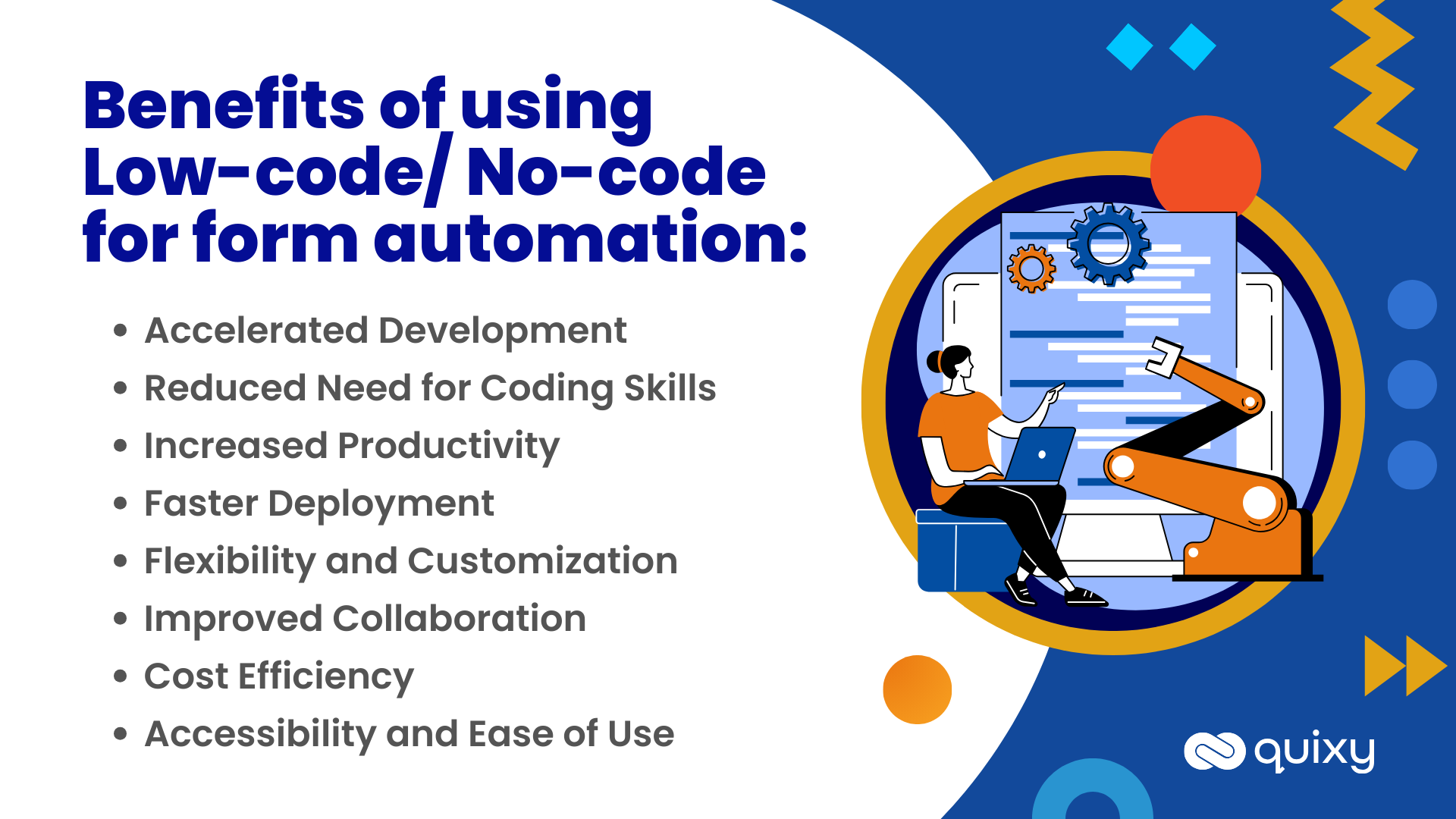
Have you ever envisioned automating your forms and workflows without the shackles of complex coding? In digital transformation, a revolutionary solution has emerged: Low-Code/No-Code platforms. These ingenious tools are reshaping the landscape of form automation, promising unparalleled efficiency and accessibility. Let’s delve into how these platforms have redefined the paradigm of form automation, liberating businesses from the confines of traditional coding. Understanding Low-code no-code for form automation!
Low-Code Platforms
Low-code platforms provide a middle ground between manual coding and fully automated processes. They empower users with a visual interface, incorporating drag-and-drop functionalities and pre-built components. This accessibility enables even those without extensive coding expertise to develop and customize applications or automate various tasks quickly.
No-Code Platforms
On the other hand, No-Code platforms take simplicity to the next level. They eliminate the necessity for coding knowledge, allowing users to build automated processes entirely through visual interfaces and pre-configured elements. These platforms cater to a broader audience, including non-technical individuals, enabling them to create efficient automated workflows effortlessly.
Advantages of Low-Code No-Code for Form Automation

1. Accelerated Development
Low-Code/No-Code platforms significantly expedite the development process by offering visual interfaces and pre-built components. This speeds up the creation of automated forms and applications, allowing businesses to adapt swiftly to changing requirements.
2. Reduced Need for Coding Skills
By leveraging these platforms, the dependency on extensive coding skills diminishes substantially. Users with minimal or no coding knowledge can design and customize automated workflows and forms, fostering inclusivity and innovation across diverse teams.
3. Increased Productivity
The streamlined process of creating automated forms enhances productivity within organizations. Tasks that previously required extensive manual input or coding can now be accomplished efficiently and swiftly, freeing up time for more strategic endeavors.
4. Faster Deployment
With Low-Code/No-Code platforms, the deployment of automated forms and applications occurs at an accelerated pace. The simplified development process ensures quicker implementation, enabling businesses to respond promptly to market demands.
5. Flexibility and Customization
These platforms offer unparalleled flexibility in customizing workflows and forms. Users can adapt and modify processes without the constraints of intricate coding, ensuring that automated systems align precisely with evolving business needs.
Also Read: What are the Top Benefits of Form Automation?
6. Improved Collaboration
The accessibility of Low-Code/No-Code platforms encourages collaboration among diverse teams. Individuals from various departments can contribute to developing and enhancing automated forms, fostering a culture of teamwork and innovation.
7. Cost Efficiency
Embracing these platforms translates to significant cost savings for organizations. Reduced reliance on professional coders and faster development cycles result in decreased expenditure, making form automation more accessible to businesses of all sizes.
8. Accessibility and Ease of Use
The user-friendly nature of Low-Code/No-Code platforms makes form automation accessible to a wider audience. The intuitive interfaces and drag-and-drop functionalities ensure ease of use, enabling individuals with varying technical backgrounds to participate effectively in the automation process.
By harnessing the myriad benefits of Low-Code/No-Code platforms, businesses can revolutionize their form automation strategies, fostering efficiency, innovation, and adaptability in today’s dynamic market landscape.

Application of Low-Code No-Code for Form Automation
Data Collection and Processing
Organizations heavily rely on data collection for various purposes. Low-Code/No-Code platforms facilitate the creation of automated forms for data collection, ensuring accuracy, efficiency, and seamless processing. From customer feedback forms to internal data gathering, these platforms streamline the entire process.
Workflow Automation
Automating workflows through Low-Code/No-Code platforms optimizes repetitive tasks and processes within an organization. Tasks such as approvals, notifications, and data routing can be automated, freeing up valuable human resources to focus on more complex and strategic initiatives.
Also Read: Essential Features of Form Automation Software
Integration with Existing Systems
Another notable advantage is the ease of integration with existing systems. Low-Code/No-Code platforms often offer compatibility with various third-party applications, enabling seamless integration with an organization’s existing software ecosystem.
Challenges and Considerations
While Low-Code/No-Code platforms offer numerous benefits, it’s essential to acknowledge potential challenges. These may include limitations in customization for highly complex processes or specialized requirements. Additionally, ensuring adequate security measures to protect sensitive data remains a critical consideration.
Conclusion
Utilizing Low-Code/No-Code platforms for form automation presents a transformative opportunity for businesses seeking efficient and cost-effective solutions. The advantages, including rapid development, cost-efficiency, accessibility, and flexibility, outweigh the challenges, making these platforms an invaluable asset in modernizing workflows.
Frequently Asked Questions(FAQs)
Q. Can individuals without coding expertise use LCNC platforms?
Absolutely! Low-Code/No-Code platforms are designed to be user-friendly, allowing individuals with minimal or no coding knowledge to create and customize automated workflows and forms effectively.
Q. What types of forms can be automated using LCNC platforms?
Low-Code/No-Code platforms can automate various forms, including customer feedback forms, surveys, registration forms, order forms, and more. They offer flexibility to adapt to diverse form requirements.
Q. How do LCNC platforms ensure data security in automated forms?
These platforms often incorporate security measures such as encryption protocols, user authentication, and compliance with data privacy regulations. They prioritize data protection to maintain the integrity of automated forms.
Q. Can automated forms created with LCNC platforms integrate with existing software?
Yes, these platforms often support integration with other applications and systems through APIs (Application Programming Interfaces). This facilitates seamless connectivity and data exchange between different software.
Q. Are Low-Code/No-Code platforms cost-effective for businesses?
Yes, adopting these platforms can significantly reduce costs associated with hiring specialized coders. Their streamlined development process and reduced reliance on coding expertise translate to considerable cost savings.
Login
Please login to comment
0 Comments
Oldest















